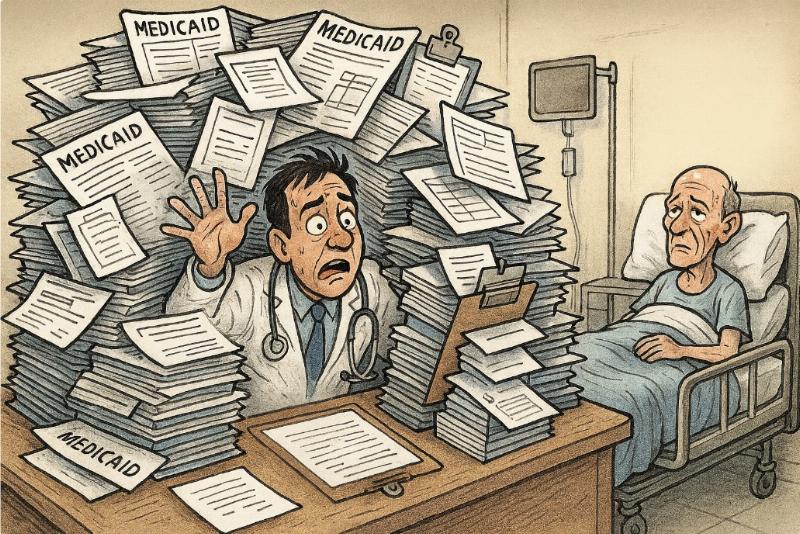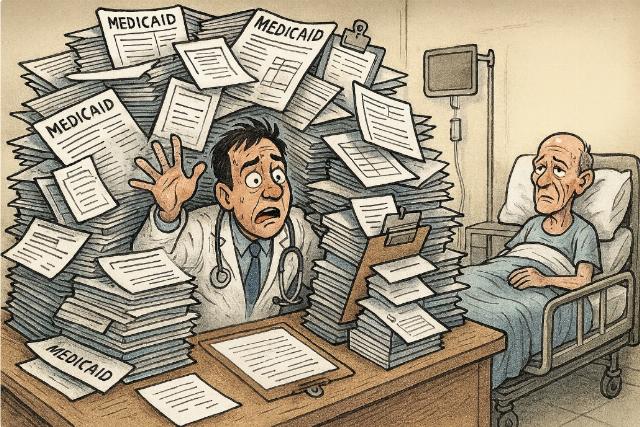


The current federal government shutdown is framed by Democrats as an attempt to “protect Medicaid” enrollees from “devastating” cuts in coverage by the Trump administration. Republicans argue that Medicaid should be focused on truly medically vulnerable citizens and should not be paying for illegal residents or healthy adults who have returned to work. Both sides miss (or ignore) the real point: the U.S. healthcare system is failing Americans because it rewards bureaucracy, not care, effectively wasting trillions of dollars a year.
Medicaid was never meant to be the sprawling entitlement it is today. In 1965, it was designed to cover less than 2% of the population, specifically those who were truly medically vulnerable. Following expansions under President Obama’s Affordable Care Act and the COVID lockdowns and emergency declarations of both the Trump and Biden administrations, nearly one in four Americans is now enrolled. Many are healthy, working-age individuals eligible for employer coverage.

Image created using AI
Republican proposals to trim Medicaid would improve the rolls, reduce its $900 billion annual price tag, and focus resources on those who genuinely need help. Medicaid is not only fiscally unsustainable but also medically inefficient, with too many dollars lost to “BURRDEN”—bureaucracy, unnecessary rules, regulations, directives, enforcement, and noncompliance.
When administrators are paid first, too little remains for providers, and the result is deadly. Medicaid enrollees often suffer long wait times and literally die waiting for care—“death by queue.” Georgia’s new Medicaid Pathways program spent $54 million on bureaucracy last year while delivering just $26 million in actual healthcare.
Georgia is not an outlier; it’s the norm. Medicaid spends more and more on BURRDEN, leaving less and less for patients. Meanwhile, the American Medical Association reported national health spending in 2023 rose to $4.9 trillion—$14,570 per person—outpacing GDP growth. Americans are paying more, waiting longer, and dying in line.
The U.S. doesn’t lack spending. It lacks a system that prioritizes patients over paperwork.
Consider employer-sponsored insurance. A $300 billion federal tax exclusion means workers never see part of the money they earn. Instead, it flows into costly, one-size-fits-all coverage chosen by HR, creating “job lock” that traps employees in positions solely for the sake of insurance.
Medicaid’s spending formula magnifies the problem. States get more federal money the more they spend, with little to no accountability. Programs waste billions on administration while patients go untreated. Studies show Medicaid enrollees often fare no better than the uninsured, and one-third of doctors refuse new Medicaid patients.
Meanwhile, outdated certificate-of-need laws, scope-of-practice limits, and cumbersome, time- and money-wasting billing mandates restrict supply, reduce competition, and drive up costs. Administrative expenses consume up to 50% of U.S. healthcare spending, double the OECD average. Nearly one-fifth of the U.S. GDP is allocated to healthcare, yet incentives ensure that the bureaucracy thrives while patients wait for care that never comes.
The result: bigger bills, longer waits, and fewer choices for families—while bureaucrats prosper. Real reform means flipping incentives so patients, not administrators, come first.
Here’s how:
First, shift the tax benefit from employers to employees. Give families control of their healthcare dollars in no-limit health savings accounts. That means higher wages, portable coverage, and personalized plans.
Second, block grant Medicaid to the states. Washington’s open-ended funding fuels overspending. Capped support would encourage state innovation, such as time-limited personal HSAs for Medicaid that promote self-sufficiency.
Third, cut red tape. Repeal certificate-of-need laws and scope-of-practice restrictions so more professionals can meet patient needs directly.
Fourth, unleash innovation. Price controls, FDA delays, and politically driven subsidies weaken America’s biotech edge as China races ahead. Patients win when innovators compete to deliver faster cures at lower costs.
These reforms would lower costs and restore the principle that healthcare should serve families, not bureaucracies. Workers would see higher take-home pay. Patients would gain faster access to care. Americans would benefit from lower prices and new treatment options.
Washington’s spending doesn’t measure compassion. It’s measured by whether a parent can get a sick child treated promptly, whether seniors can afford their prescriptions, and whether breakthroughs reach patients promptly.
Healthcare reform isn’t about Washington saving the system it broke. It’s about trusting We the People (“We the Patients”), empowering states, and unleashing free markets. Until we enable patients and providers instead of bureaucrats and politicians, we’ll keep pouring trillions into a system where Americans pay for the privilege of waiting in line to die.
Vance Ginn, PhD, is president of Ginn Economic Consulting, and previously served as chief economist of the White House’s Office of Management and Budget during the first Trump administration. Follow him on X @VanceGinn or visit vanceginn.com. He co-authored Empower PATIENTS – Two Doctors’ Cure for Healthcare with Dr. Deane.
“Dr. Deane” Waldman, MD, MBA, is professor emeritus of pediatrics, pathology, and decision science; and former director of the New Mexico Health Insurance Exchange. Follow him on X @DrDeaneW or visit deanewaldman.com.
